A local fish store would usually house common varieties of Fish, such as Goldfish, Angelfish Koi, Arowana, and Flowerhorn, as well as Livebearers, Corydoras, Tetra, Danio, and Gourami. But there are certain types of Fish customers are usually curious about because of their looks, size, and shape, I call them “unusual looking Fishes.”

1. TIGER SHOVELNOSE CATFISH
Also known as the Tiger Catfish, the Tiger Shovelnose Catfish is aggressive and has massive mouths that can easily eat small Fish. However, they rarely eat their tank mates if well fed.
APPEARANCE
The Tiger Shovelnose Catfish has a long and slender body with beautiful silver and black coloration and black stripes. Their entire body has spots.
They have large, flat mouths with long whiskers and are four feet in length in the wild, although they are merely two to three feet long in captivity.
DIET
These omnivores should be fed large feeders and commercial sinking pellets along with small slices of fresh market Fish.
CARE
Tiger Shovelnose Catfish are energetic, so the aquarium should be covered to prevent them from jumping out of the tank.
TANK MATES
Large Fishes, such as giant Gourami, Pacu, and Cichlids like Oscar Fish and Severums, can serve as their tank mates.
TANK SETUP
These should be set up with driftwood, plants, bogwood, and rocks.
WATER CONDITIONS
The water should be soft and acidic.
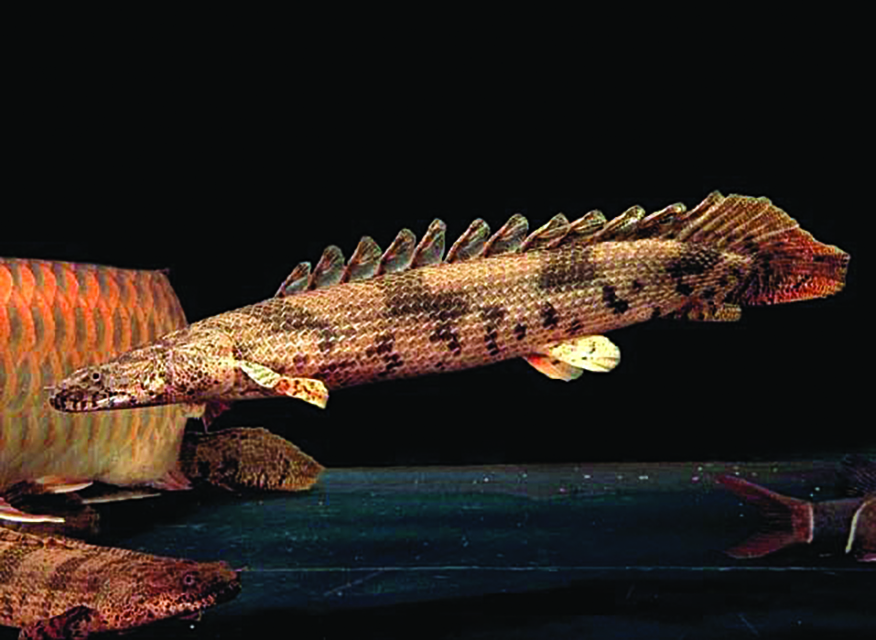
2. BICHIRS
Sometimes called Dragon Fin because of their dragon-like appearance, this Fish adds a prehistoric feel to your aquarium. They are predatory but peaceful. However, they cannot be kept with smaller Fish because they can bully or eat them.
In captivity, they can live up to 10 to 15 years. These nocturnal bottom-dwellers prefer feeding during the night. They have poor eyesight and rely mainly on other senses to find food.
There are several types.
• Dinosaur Bichir
• Albino Bichir
• Ornate Bichir
• Saddled Bichir
• Delhezi Bichir
Here are a few things one needs to know about them.
APPEARANCE
Bichirs have long Eel-like bodies that will add a peculiar appearance to your tank. On the top of their backs, they have a series of spiny dorsal fins.
They have paired lungs that help gas exchange in poorly oxygenated environments. They have two small openings on the top of their head which they breathe through. They have an average size of 1-2.5 feet.
TANK MATES
They usually do well with larger Fish, such as think Oscars, Blood Parrots, Flowerhorns, large Barbs, Knifefish, medium and large Catfish, and large peaceful African Cichlids.
TANK SETUP
The most important thing in a Bichir’s tank is a sandy substrate. Plants are also useful in providing cover from the light.
They can survive in low-oxygenated water quite easily as they don’t have specific filtration or aeration requirements. However, they still need a good filtration system to get rid of the toxic chemicals.
You should also put a cover on your aquarium.
WATER CONDITION
Bichirs prefer shallow, swampy waters and can thrive in semi-brackish waters. The water is preferably soft and acidic.
DIET
Bichirs are carnivorous fishes. It is recommended to feed them Bloodworms, frozen Shrimps, small Fish, and Earthworms.

3. CLOWN LOACH
They are called “Clown” Loach because of their strange habits, such as swimming upside down and on their sides. Sometimes they like playing dead, but they eventually return to their usual behavior.
DIET
Commercial flake food and sinking pellets are their dietary staple. They also love other varieties of food, such as live Worms, brine Shrimp, and small Snails.
APPEARANCE
They have a long, pointed nose with sensitive whisker-like barbs. They have two wide, black, V-shaped stripes along the sides of their body and a third black stripe running vertically through their eye.
TANK MATES
They are peaceful both on their own and with other fishes like Silver Dollar, Goldfish, and Angelfish. They make suitable tank mates for any non-aggressive Fish, but do not thrive when kept with bigger, more dominant species. Six to eight of them together will make them happy.
CARE
Clown Loaches are active, large, schooling Fish. They should have several hiding spots such as ceramic pots, driftwood, rocks, and plants. Loaches are prone to ich infections, so water quality is very important. Also, avoid sudden water fluctuations.

4. GLASS CATFISH
This timid, transparent freshwater Catfish has a lifespan of seven to eight years. The ghost Catfish appearance is not only fascinating but also protective against predators, as their transparency allows them to be invisible.
APPEARANCE
They are four to five inches long. They are transparent because they are scaleless.
TANK MATES
They can be kept with other Fish species of similar size and temperament. Fish like Swordtails, Neon Tetras, peaceful Tetras, Guppies, and Mollies are best for them.
DIET
Their diet consists of brine Shrimp, Bloodworms, Pellets, and flakes.
TANK SETUP
Their tank should have hiding spots and sandy substrates.
WATER CONDITION
Glass Catfish are highly sensitive to changes in water quality and pH.
DID YOU KNOW?
Most of their organs are located near the head.
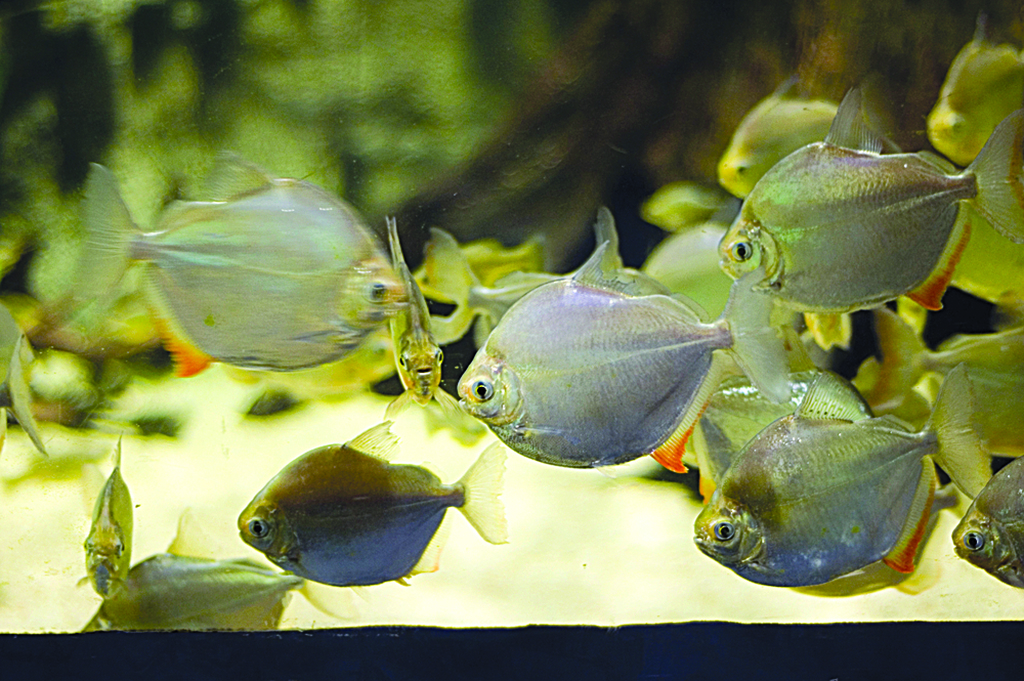
5. SILVER DOLLAR
This peaceful, medium-sized Fish has a lifespan of 10 years and is ideal for community aquariums. They belong to the Characidae family.
APPEARANCE
They are six inches long and look like an old silver dollar because of their flat body.
DIET
Their diet consists of both meat and plants as they are omnivores.
CARE
They are large, peaceful schooling Fish who need plenty of swimming space. You should keep them in a group of at least five individuals. They can be quite skittish and reclusive if kept alone. Other popular types are spotted Silver Dollar and Red Hook Silver Dollar.
TANK SETUP
They mainly swim in the middle and top part of the water column, so they need open areas for swimming.
They are jumpy Fish who prefer dim lighting and background. We suggest using dark-colored gravel as a substrate. You need a lot of open space but also some hiding places around the back and sides of the tank.
DIET
They are omnivorous fish but prefer an herbivorous diet. They usually feed on the surrounding vegetation, including terrestrial plants like lettuce, seaweed, and large vegetable flakes.
They can have treats like bloodworms, brine shrimp, and boiled potatoes.
TANK MATES
These are great community Fish. Ideal tank mates are Catfish and South
and Central American Cichlids. Giant Daniosand Pacus are also good tank companions. Silver Dollars are at their best when kept together.
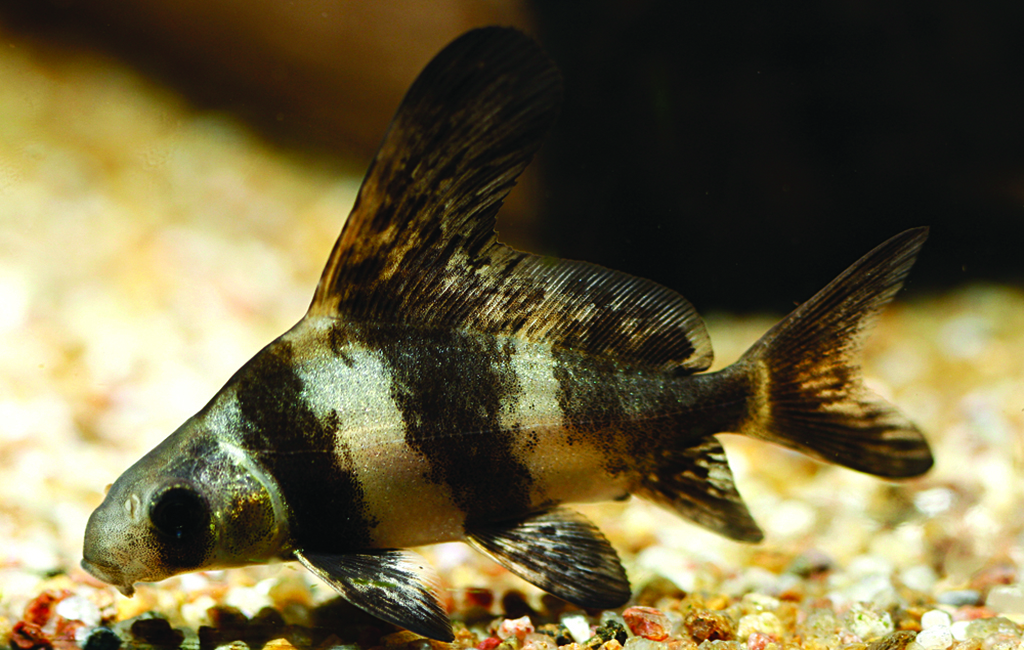
6. CHINESE HIGH-FIN BANDED SHARK
The Chinese High-Fin Banded Shark is a popular freshwater aquarium Fish from the family Catostomidae. Despite having “Shark” in their name, they have no relation to real Sharks. They belong to the species of freshwater Fish resembling Sharks. They are not active swimmers, and they will not swim around regularly.
APPEARANCE
Young Chinese High-Fin Banded Sharks normally have brown bodies bearing three dark-colored slanting bands with high and triangular dorsal finnage. Through adulthood, Chinese High-Fin Banded Sharks become darker in color.
In five to six years, the fish will grow to 1.35 meters in length and weigh 40 kilograms.
LIFE SPAN
Expect them to live up to 15 years or more.
TANK SETUP
While this Fish makes a great aquarium keep, they’re not suitable for most home tanks. They are much more suitable in a community aquarium or a pond, which will provide them the space they need.
Use a substrate of sand or fine gravel. Add enough plants and some driftwood or bogwood and rocks. However, do not overcrowd the tank.
DIET
They are herbivores, so you should provide your sharks with a variety of food, such as live, fresh, or frozen
food materials: Crustaceans, Earthworms, Bloodworms, Insects, Annelids, Prawn, Tubifex, small Mollusks, and quality pellet or flake foods that can sink to the bottom of the tank.
For juveniles, they enjoy a frozen Bloodworm diet.
WATER CONDITION
A water pH level between 6.8 to 7.5 is good for the High- Fin Banded Shark. They are affected by abrupt changes in water quality.
TANK MATES
The Chinese High-Fin Banded Shark can get along with various Fish species due to their peaceful nature. They make great tank mates for Loaches, Goldfish and Koi Fish. About three to five of these Sharks in an aquarium will make them feel safer.
MULTIPLE NAMES
They are also called Chinese Banded Shark, Chinese Sailfin Sucker, High-Fin Banded Loach, High-Fin Loach, Chinese High-Fin Sucker, Sailfin Sucker, and Entsuyui in Japanese.
Talk about having many nicknames!
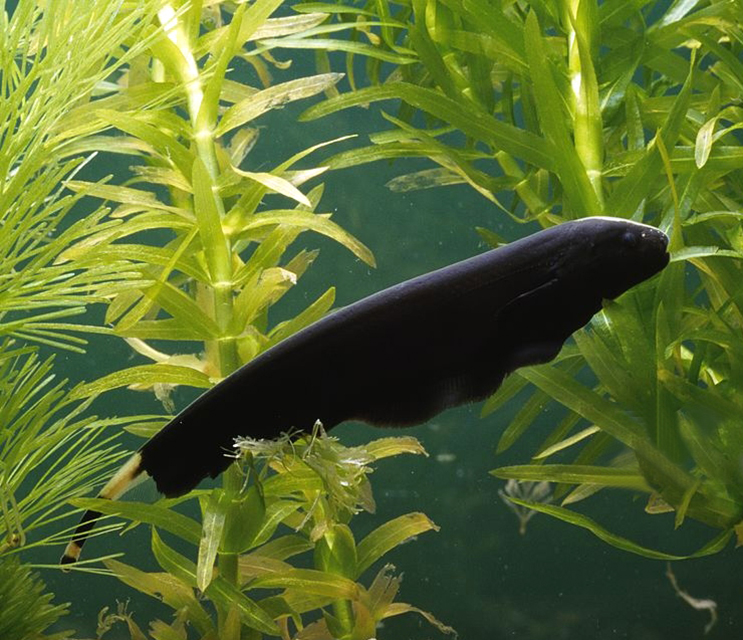
7. BLACK GHOST KNIFE
This popular Fish got their name from the story that dead souls inhabit them.
APPEARANCE
They resemble a knife, with their almost dark bodies, aside from the white rings on their tail and a white stripe on their nose. Their long, flat, scaleless body can reach up to 20 inches.
LIFESPAN
They have an average lifespan of 15 years if they are properly cared for.
DIET
They are also carnivores who consume live food in the form of flakes, sinking bits, and chopped Earthworms.
TANK SETUP
Their tank should be a minimum of 150 gallons to reach maximum size. The lighting should be dim and the tank should have hiding places; otherwise, the Fish may become aggressive.
Other peaceful and similar-sized Fish, such as Catfish or Cichlids, are recommended as tank mates. However, they are better off without others of their own kind as they tend to become aggressive towards one another. Each added tank mate should also be at least six inches in size.
DID YOU KNOW?
This nocturnal Fish can navigate dark waters by electrolocation.
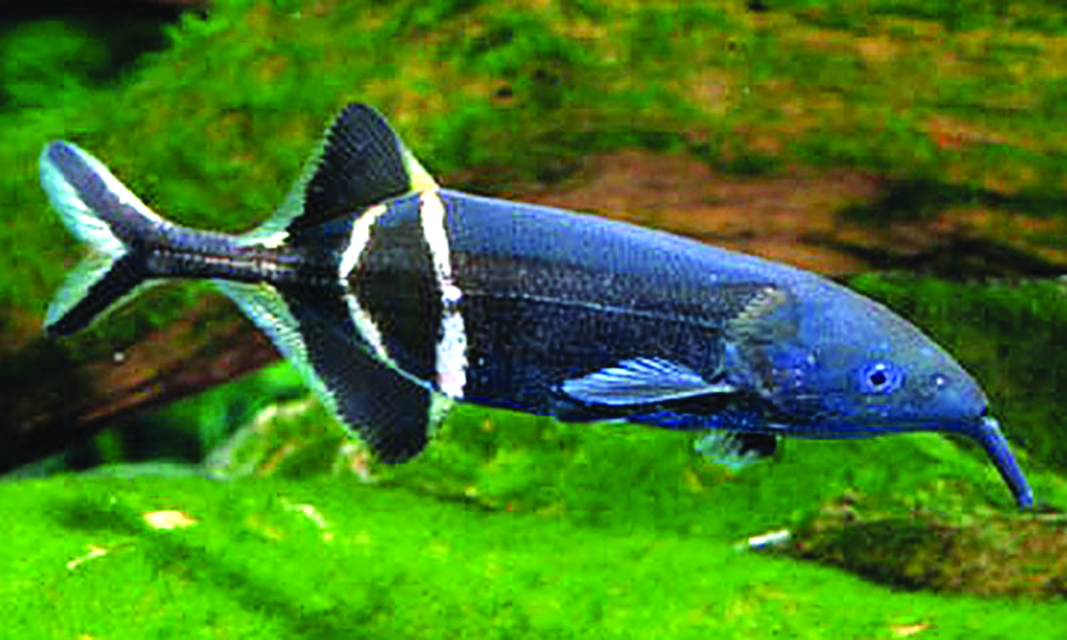
8. ELEPHANT NOSE
This Fish from the Niger becomes docile once they properly adapt to their surroundings.
APPEARANCE
They are a mix between a sword and an Elephant because of their long, thin body and a long nose that droops slightly downward. Their heads are pointed and thin while their dorsal and anal fins are almost reflections of each other.
They normally grow up to about nine inches. They are colored black or dark brown with a white streak between the front ridge of the dorsal and anal fins and another about an inch to the back.
They are also known as the Long-Nosed Elephant Fish, Elephant Fish, and Peters’ Elephant Nose Fish.
LIFESPAN
The average lifespan is six to ten years.
DIET
These carnivorous Fishes consume meaty foods including Bloodworms, chopped Earthworms, frozen meaty food, and pellets.
TANK SETUP
The tank should be about 50 gallons as they are large Fish and extra space always helps create a suitable habitat. The tank should be filled with vegetation, such as hornwort, anubias and Java moss for the fish to interact with.
TANK MATES
They get along with other peaceful, larger Fishes, but can be aggressive to smaller Fishes. Some examples of good tank mates are Bichir, Congo Tetra and Cory Catfish.
Based on my experience, they are not suitable for beginners. Most of them require large-sized tanks and strong filtration. It’s better for one to have more than two years caring for fish before one can care for these beautiful, unusual Fish.
For questions, please email [email protected].
“The Lord is not slow to fulfill his promise as some count slowness, but is patient toward you, not wishing that any should perish, but that all should reach repentance.” 2 Peter 3:9 ESV






